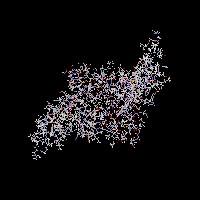Human BMP4
Review: This gene and it's protein have been implicated angiogenesis, ossification, skeletal development, and bone mineralization to name a few. It is overexpressed in FOP.
Molecular Class: Ligand
Molecular Function: Receptor Binding and Structural protein
Biological Processes: Signal transduction and Cell communication
Domain Family:
 The major domain family in BMP4 is the transforming growth factor beta family or TGF-B. The defining characteristics of the members in this family are the presence of disulphide-linked homo- or heterodimers. The TGF-B is a peptide that controls the proliferation, differentiations and other functions in different cell types. An indepth look at TGF-B domain reveals interesting aspects of this family.
The major domain family in BMP4 is the transforming growth factor beta family or TGF-B. The defining characteristics of the members in this family are the presence of disulphide-linked homo- or heterodimers. The TGF-B is a peptide that controls the proliferation, differentiations and other functions in different cell types. An indepth look at TGF-B domain reveals interesting aspects of this family.
Motifs:
The major motif is the signal peptide or SP which is a stretch of hydrophobic amino acids.
Localization:
This protein is primarly localized in the extracellular region outside of the cellular matrix. In fact, it is the extracellular calcium that effects the expression of BMP4 in normal human bone cells (Nakade et al. 2001).
Using the k-NN prediction method of PSORT II the following results were obtained for BMP4: 33.3% (cytoskeletal), 33.3% (nuclear), 22.2% (cytoplasmic) and 11.1% (mitochondrial). PSORT got it wrong - it didn't even guess "extracellular" which is the right answer.
Regulation:
BMP4 is activated by MSX1, GLI and GLI3; cleaved by subtilsin-like convertases (furin) PACE; and inhibited by FGF4, BARX1 and noggin; it is associated with TSG and CHRD. (Genatlas)
Primary and Secondary Structure Features:
Coiled-Coils: Using the program COILS I found that my protein doesn't have a colied-coil region as the graph only shows a 10% chance of coiling at a couple of different places in the protein.
Molecular Weight: 45886.04 Da (ExPASy)
pI: 8.86 (ExPASy)
I tried using drawhca, Helical Wheel, M.M., pI, composition, titrage and SAPS as well, but had no luck.
Posttranslational Modifications:
Glycosylation: Zero sites of glycosylation were predicted in the human BMP4 sequence.
Tyrosine Sulfation: Zero sites of tyrosine sulfation were predicted in the human BMP4 sequence.
Phosphorylation: Serine (11), theronine (3), and tyrosine (3) were prediction in the human BMP4 sequence.
**My favorite site for looking at this protein is the Human Protein Reference Database. It has a nice interface and gives lots of information about the location, domains, motifs, diseases, sequences and more. It also provides links to other websites.

<< Home